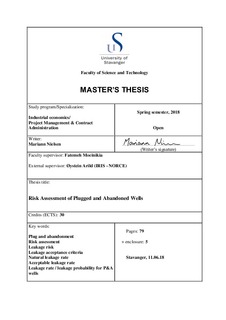| dc.description.abstract | During the next decades, a large number of wells needs to be plugged and abandoned on the Norwegian Continental Shelf (NCS). The cost of plugging these wells will be enormous (Straume, 2014). One of the elements that affects the costs related to P&A is the regulations. Today, the regulations are in practice prescriptive. However, this thesis studies the possibility and the benefits of having a risk-based regulation for P&A. The essence is then to measure the quality of different P&A solutions in terms of leakage rate and probability. Then it would be easier to accept new solutions for P&A and use cheaper solutions if these were considered safe enough. Performing a risk assessment of P&A wells would also give the industry valuable knowledge about the risk associated with plugged and abandoned wells.
If a risk-based regulation for P&A were to be implemented, then the risk acceptance criteria should be established. Risk acceptance criteria tells us whether the risk is acceptable or not. The recommended solution is to use the ALARP triangle, where the consistency between wells method reflects the lower criterion and the natural seepage rate reflects the upper criterion. In the ALARP region, one should aim to reduce the risk to a level that is As Low As Reasonably Practicable (Aven, 2015).
The consistency between wells method estimates the leakage rate for a worst case well abandoned according to regulations. This is identified as best practice, as this would replace today’s requirements in terms of leakage rate. Natural seepage rate should reflect the higher criterion. The leakage rate from natural seeps is considered acceptable as these rates are quite low, giving the marine environment time to adapt into the new conditions. In addition, the leakage from natural seeps is permanent (long-lasting), which would also be the case for P&A wells, as no one is there to stop the leakage (due to no monitoring). However, allowing the same leakage rate as natural seeps would disturb the natural balance and one should therefore reduce the risk unless the costs are in gross disproportion to the benefit gained.
As mentioned earlier, performing a risk assessment of P&A wells includes quantifying the probability of leakage and the leakage rate. To quantify the probability of leakage, the recommended solution is to use a Bayesian approach together with the Weibull distribution. This method allows the use of only censored data as there are no leaks reported in P&A wells on the NCS. With this approach, one can also include prior information available from experts, models etc. In addition, this method takes into account that the probability changes with time, as one assumes an increasing failure rate.
To quantify the leakage rate, a leakage calculator has been developed by Ford et al. (2017). The leakage calculator has two sets of inputs; deterministic (fixed values such as plug length, virgin reservoir pressure etc.) and uncertain (such as cement permeability, fracture width etc., represented using a probability distribution). This leakage calculator currently considers the following leakage paths: through bulk cement, fractures/cracks and in the micro-annuli. The calculator then integrates this information in order to describe the overall leakage rate potential for a failed permanent barrier system (Ford et al. 2017).
Lastly, a case study was performed. The result of this case study shows that a shorter plug length for LPLT (low pressure / low temperature) wells should be accepted when plugging these wells. For example, it was shown that a 30 m formation to formation plug for this well would have a leakage rate in the acceptable region. Reducing the plug length from 50 to 30 m would save money as this would require less time.
The conclusion is that a risk-based regulation for P&A will result in cost efficient solutions where the quality is maintained. | nb_NO |

